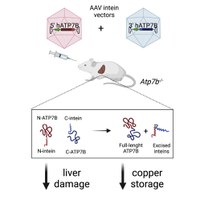Full-length ATP7B reconstituted through protein trans-splicing corrects Wilson disease in mice
Authors: Agnese Padula, Raffaella Petruzzelli, Sasha A.Philbert, Stephanie J.Church, Federica Esposito, Severo Campione, Marcello Monti, Filomena Capolongo, Claudia Perna, Edoardo Nusco, Hartmut H.Schmidt, Alberto Auricchio, Garth J.S.Cooper, Roman Polishchuk, Pasquale Piccolo
Year: 2022
Sources: Molecular Therapy
Abstract:
Wilson disease (WD) is a genetic disorder of copper homeostasis, caused by deficiency of the copper transporter ATP7B. Gene therapy with recombinant adeno-associated vectors (AAV) holds promises for WD treatment. However, the full-length human ATP7B gene exceeds the limited AAV cargo capacity, hampering the applicability of AAV in this disease context. To overcome this limitation, we designed a dual AAV vector approach using split intein technology. Split inteins catalyze seamless ligation of two separate polypeptides in a highly specific manner. We selected a DnaE intein from Nostoc punctiforme (Npu) that recognizes a specific tripeptide in the human ATP7B coding sequence. We generated two AAVs expressing either the 5′-half of a codon-optimized human ATP7B cDNA followed by the N-terminal Npu DnaE intein or the C-terminal Npu DnaE intein followed by the 3′-half of ATP7B cDNA, under the control of a liver-specific promoter. Intravenous co-injection of the two vectors in wild-type and Atp7b−/− mice resulted in efficient reconstitution of full-length ATP7B protein in the liver. Moreover, Atp7b−/− mice treated with intein-ATP7B vectors were protected from liver damage and showed improvements in copper homeostasis. Taken together, these data demonstrate the efficacy of split intein technology to drive the reconstitution of full-length human ATP7B and to rescue copper-mediated liver damage in Atp7b−/− mice, paving the way to the development of a new gene therapy approach for WD.
Category: journals

